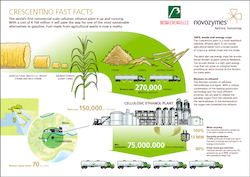 Amyris, Inc. has announced that Paulo Diniz, currently President of Amyris Brasil, will become Amyris’s Chief Financial Officer (CFO) on an interim basis following the decision of its current CFO, Steve Mills, to step down for personal reasons. Diniz will assume the new responsibilities by December 15, 2013, at which time Mills will transition to an advisory role with the Company. Amyris has begun an executive search to evaluate potential internal and external candidates to permanently fill the position.
Amyris, Inc. has announced that Paulo Diniz, currently President of Amyris Brasil, will become Amyris’s Chief Financial Officer (CFO) on an interim basis following the decision of its current CFO, Steve Mills, to step down for personal reasons. Diniz will assume the new responsibilities by December 15, 2013, at which time Mills will transition to an advisory role with the Company. Amyris has begun an executive search to evaluate potential internal and external candidates to permanently fill the position.- LDK Solar Co., Ltd. has announced the appointment of Dr. Shi Chen to its board of directors. Dr. Chen will serve as a non-executive director.
- A new plastic to oil company, Poly2Petro, has begun operations according to CEO Steven Mills. The newly established corporation plans to build and expand plastic to oil conversion facilities containing a unique system that can process co-mingled or contaminated plastic waste that no other technology can currently accomplish.
- SunEdison has launched the SunEdison Solar Water Pump, a high performance solar PV-based water pump specially designed for agriculture. The Solar Water Pump will address a significant market, and help increase crop yield by delivering reliable irrigation without dependence on expensive diesel fuel or intermittent electrical power supply.
Cellic Ctec Enzyme Featured in Cellulosic Plant
It was only a few weeks ago that one of the largest, if not the largest commercial scale advanced biofuel facility in the world using enzymatic technology marked the official opening in Crescentino, Italy. The project partners included global companies Beta Renewables and Novozymes.
 The biorefinery features Novozymes Cellic® CTec enzymes, a technology developed and refined specifically for the cellulosic ethanol industry. The multi-feedstock facility uses wheat straw, rice straw and arundo donax to produce ethanol.
The biorefinery features Novozymes Cellic® CTec enzymes, a technology developed and refined specifically for the cellulosic ethanol industry. The multi-feedstock facility uses wheat straw, rice straw and arundo donax to produce ethanol.
To learn more about Cellic and how the enzyme technology was refined for this project, I spoke with Jason Blake, Director, Biomass Conversion with Novozymes who explained that the genesis for the project began several years back. The relationship with Beta Renewables was one of collaboration that began in the lab and in the pilot facility in looking at making a commercially viable project for Beta Renewables.
Through the efforts the team has been looking at technologies and developments to optimize the process technology and optimize the enzyme technology to help them become a commercially viable player in the market. In addition, with co-marketing plans in place, the two companies plan on bringing the technologies to market to help the advanced biofuels industry grow.
So why are enzymes so important in the ethanol production process? “Enzymes are unique in the process. They play a part not just in the hydrolysis piece they can unlock opportunities along the process technology value chain, explained Blake.”
Enzymes, he explained have been able to reduce the cost of capital at the front end. “Through the development of the enzymes and increasing the performance, we’re able to reduce the enzyme dosage and reduce the hydrolysis time and increase the sugar conversions which thereby open up opportunities to invest money in other areas,” he said.
Blake also explained that the enzyme technology is optimized for each plant’s technology and feedstock allowing the company’s research and development to extend well into the future of the industry.
For more information about the collaboration between Novozymes and Beta Renewables and to learn more about the philosophy and research and development efforts of Novozymes, listen to my in-depth interview with Jason Blake. Novozymes Cellic Ctec Enzyme Featured in Cellulosic Plant
Proposed 2014 RFS Capitulation to Big Oil
The Iowa Renewable Fuels Association (IRFA) is urging the Obama Administration to conduct a thorough soul-searching after the U.S. Environmental Protection Agency (EPA) announced its proposal to “radically” reduce Renewable Fuel Standard (RFS) levels for 2014.
“Today’s RFS announcement represents the biggest policy reversal of the entire Obama Administration,” said IRFA Executive Director Monte Shaw during a press teleconference. “The EPA proposal turns the RFS on its head, runs counter to the law and is a complete capitulation to Big Oil. The Obama Administration needs to conduct a thorough soul-searching  and decide whether they are serious about cleaner fuels, consumer choice, and cutting petroleum dependence, or whether they truly want to adopt the Big Oil status quo. There is still time to restore Congressional intent and common sense before the rule is finalized.”
and decide whether they are serious about cleaner fuels, consumer choice, and cutting petroleum dependence, or whether they truly want to adopt the Big Oil status quo. There is still time to restore Congressional intent and common sense before the rule is finalized.”
Shaw explained that In the proposed rule, the Administration adopts the position that a lack of retail distribution equipment this year equates to a renewable fuel “supply shortage” next year. This “infrastructure” waiver, he said, was specifically rejected by Congress during the adoption of the RFS and, if allowed to stand, would effectively repeal the RFS as a factor in U.S. energy policy. The circular logic of this proposal, continued Shaw, creates a downward death spiral for the RFS as the RFS could not be increased unless Big Oil had already begun to offer higher ethanol blends. With no pressure to move forward, Big Oil would be expected to continue hiding behind its Century of Subsidies and Federal Petroleum Mandate to prevent consumer choice for higher blends.
“It’s not just the absurdity of lowering the 2014 numbers below the 2013 level, with the new waiver framework, in essence, the Administration would be ceding power to the petroleum industry to dictate the level of each year’s RVO based on the amount of infrastructure the petroleum industry was willing to install,” Shaw opined. “That is the exact opposite of how the RFS was intended to work. The RFS is supposed to be a tool for market access, not market restriction.”
In addition to creating an extra-legal waiver mechanism, the proposal lowers the “corn ethanol” level from 13.8 billion gallons in 2013 to only 13 billion gallons in 2014. The proposal also freezes the biodiesel level at 1.28 billion gallons despite the fact the biodiesel industry is currently operating at an annualized rate of 2 billion gallons.
“The 2014 numbers represent the real crossroads,” concluded Shaw. “We either move toward more competition and more consumer choice or we lock in the current petroleum monopoly. When faced with that choice, the Obama Administration has blinked. I think we’ve just seen how politically powerful Big Oil really is. They just got what they wanted from the EPA when they had no chance of gutting the RFS through Congress. With no Farm Bill and the RFS in danger of being rendered useless, I hope we don’t look back at November 15, 2013 as the beginning of the next farm crisis.”
Listen to Monte Shaw’s full comments here: Proposed 2014 RFS Capitulation to Big Oil
Ethanol, Corn Industry Outraged at EPA RFS Proposal
The ethanol and corn industry is outraged over the Environmental Protection Agency’s (EPA) proposed 2014 renewable fuels volumes as part of the Renewable Fuel Standard (RFS). The renewable fuel category, of which the majority is comprised of corn-based ethanol, is proposed at 15.21 billion gallons.
 “This recommendation is ill-advised and should be condemned by all consumers because it is damaging to our tenuous economy and short-sighted regarding the nation’s energy future,” said NCGA President Martin Barbre, who said the proposed number would reduce volumes for corn-based ethanol. “Agriculture has been a bright spot in a failing U.S. economy, but current corn prices are below the cost of production. EPA’s ruling would be devastating for family farmers and the entire rural economy.”
“This recommendation is ill-advised and should be condemned by all consumers because it is damaging to our tenuous economy and short-sighted regarding the nation’s energy future,” said NCGA President Martin Barbre, who said the proposed number would reduce volumes for corn-based ethanol. “Agriculture has been a bright spot in a failing U.S. economy, but current corn prices are below the cost of production. EPA’s ruling would be devastating for family farmers and the entire rural economy.”
The proposed rule caps corn-based (or conventional) ethanol at 13 billion gallons. These proposed volume obligations are a drastic reduction from the mandated RVOs in statute, according to Barbre. This proposed rule cuts 1.4 billion gallons from the conventional ethanol cap that was set at 14.4 billion gallons.
He also noted the EPA proposal will make investments in new biofuels plants very risky, stagnate investment in infrastructure by petroleum marketers and send the wrong signals to automakers who want more direction on where they should be spending millions of targeted investments on research and development.
Brian Jennings, executive vice president for the American Coalition for Ethanol (ACE) said of the proposed rule, “There is nothing positive that can be said about EPA’s proposal to unnecessarily restrict sales of ethanol-blended  fuel in 2014. This proposed rule will increase pump prices, drain billions of dollars from consumer pocketbooks, and transfer billions more to oil company profit statements. EPA’s proposal fundamentally betrays this Administration’s commitment to clean renewable fuels and caves to Big Oil demands to put a ceiling on ethanol use.”
fuel in 2014. This proposed rule will increase pump prices, drain billions of dollars from consumer pocketbooks, and transfer billions more to oil company profit statements. EPA’s proposal fundamentally betrays this Administration’s commitment to clean renewable fuels and caves to Big Oil demands to put a ceiling on ethanol use.”
“We are deeply disappointed in EPA and will try to help them come to their senses before the final rule is published, by helping the Administration better grasp the role E15 and E85 can play in meeting the 2014 RFS” continued Jennings. “This proposal likely violates the law, would shut down biofuel facilities, put Americans out of work, and chase investment in advanced biofuel overseas to our competitors.”
Jennings also noted that the proposed rule sets a dangerous precedent by taking the teeth out of the most consequential policy Congress has ever enacted to reduce greenhouse gas emissions of transportation fuel, a sentiment that others in the ethanol industry agree with.
Barbre indicates that the proposal as it stands would also hurt American farmers. Read More
Biodiesel Cavitation Process Gets Patent Approval
 A new process for producing biodiesel gets approval from the U.S. Patent and Trade Office (USPTO). Cavitation Technologies, Inc.’s (CTi) process, titled ‘Process for Producing Biodiesel through Lower Molecular Weight Alcohol-Targeted Cavitation,’ received the green light from USPTO.
A new process for producing biodiesel gets approval from the U.S. Patent and Trade Office (USPTO). Cavitation Technologies, Inc.’s (CTi) process, titled ‘Process for Producing Biodiesel through Lower Molecular Weight Alcohol-Targeted Cavitation,’ received the green light from USPTO.
“This newly patented hydrodynamic cavitation technology and process has demonstrated that it can reduce costs and significantly lessen the environmental impact associated with biodiesel production,” stated CTi’s Chief Technology Officer, Mr. Roman Gordon. “Working in cooperation with our strategic business partners, Desmet Ballestra and GEA Westfalia, the Company will initially target North and South American biodiesel producers for new and retrofit installations.”
Mr. Gordon continued, “There are numerous biodiesel plants located throughout North and South America and many of these plants are currently seeking improved and innovative production methods. We certainly believe our technology can fill the current needs of those biodiesel producers.”
“Compared to conventional methods of biodiesel production, CTi’s process can offer superior quality biodiesel while minimizing the amount of harsh chemicals used and lowering operational costs for producers. Furthermore, our process has demonstrated that this can all be accomplished in an environmentally sound manner,” concluded Mr. Gordon.
Last month, CTi announced the development of its Nano Neutralization(R) Reactor System in Brazil, which processes approximately 500 tons of soybean oil daily and should be ready to use in June 2014.
Vilsack Defends EPA’s Slashing of RFS
 Secretary of Agriculture Tom Vilsack is defending the Obama Administration’s proposal to cut the 2014 Renewable Volume Obligations (RVOs) as part of the Renewable Fuel Standard (RFS) for the amount of renewable fuels to be blended into gasoline and diesel. But some of the people he spoke to, along with several biofuel advocates, are questioning the legality of the cuts. The Environmental Protection Agency has proposed to set the cellulosic biofuel category at 17 million gallons, biomass-based diesel at 1.28 billion gallons, advanced biofuel at 2.20 billion gallons and renewable fuel at 15.21 billion.
Secretary of Agriculture Tom Vilsack is defending the Obama Administration’s proposal to cut the 2014 Renewable Volume Obligations (RVOs) as part of the Renewable Fuel Standard (RFS) for the amount of renewable fuels to be blended into gasoline and diesel. But some of the people he spoke to, along with several biofuel advocates, are questioning the legality of the cuts. The Environmental Protection Agency has proposed to set the cellulosic biofuel category at 17 million gallons, biomass-based diesel at 1.28 billion gallons, advanced biofuel at 2.20 billion gallons and renewable fuel at 15.21 billion.
In remarks before farm broadcasters during the 70th National Association of Farm Broadcasting Annual Convention in Kansas City, Vilsack said EPA’s unprecedented number of comments in the proposal shows how much the agency wants to work with the biofuels industry to make sure their fuels will work for American consumers.
“What EPA has done is essentially said ‘We are very interested in maintaining this industry, and we need information from the industry as to policies and programs, in addition to the RFS, that would allow this industry to be more sustainable and more profitable,'” Vilsack said, adding that as part of the comment period for this RVO proposal, the industry will get more input on policies.
As far as USDA is concerned, he said his folks will concentrate on parts of the industry they can control, pointing to programs such as Rural Energy for America Program (REAP), which provides funds for infrastructure to make sure those higher blends biofuels can be available.
“I think our challenge is to work with the industry … that they need work to create a distribution system, and that they can’t rely on the petroleum industry [to do it for them].”
When pressed by Michelle Rook of WNAX about the authority that EPA had to set RVOs lower than what the law allows, Vilsack, while pointing out he doesn’t run the EPA, said the law does allow for the waiving of statutorily mandated requirements.
“[EPA] would say the reason they are reducing the numbers is because we are at a point where the amount of fuel being consumed in this country is 130 billion gallons,” and when you figure on the distribution problems he said needed to be worked on that basically limit to a 10 percent ethanol blend, that caps how much the EPA can require. “That’s why the EPA went the extra mile of saying, ‘Hey, we have to figure out how to get more higher blends in the marketplace. Give us your ideas.'”
Vilsack pointed to how USDA is working with the EPA, the military and civilian aviation industries to expand biofuel use in those areas as his agency’s commitment to making sure the RFS and biofuels industries are successful.
You can hear Vilsack’s remarks specifically about the RFS here: Secretary Vilsack Press Conference comments on RFS
And you can hear the entirety of what he had to say to farm broadcasters here: Secretary Vilsack Press Conference
REG Opens Biodiesel Barge Berth at Seneca, Illinois
 Renewable Energy Group has opened a new biodiesel loading facility on the Illinois River. This REG news release says it will help move the green fuel from REG’s 60-million gallon biorefinery in Seneca, Ill.
Renewable Energy Group has opened a new biodiesel loading facility on the Illinois River. This REG news release says it will help move the green fuel from REG’s 60-million gallon biorefinery in Seneca, Ill.
The barge loading facility will be supported by the addition of 2.5 million gallons of new terminal storage. REG’s total investment in these upgrades is about $4.5 million.
“The barge berth at REG Seneca further enhances our lower-cost, efficient business model,” said Daniel J. Oh, President and CEO of Renewable Energy Group, Inc. “Adding more barge capabilities to our network of biorefineries and terminals across the country gives REG another capability for providing high quality biodiesel to our existing and future customers.”
“Every full barge that leaves Seneca equates to about 65 truckloads of biodiesel,” said Brad Albin, REG Vice President, Manufacturing. “This not only increases efficiencies, but expands the geography and customer base we can cover through the inland waterways system.”
Biodiesel is also leaves Seneca by truck and rail, and the company has barge and deepwater ship loading capability In Houston and the New York City area. REG owns and operates eight biodiesel refineries in four states able to produce up to 257 million gallons a year.
EPA’s RVO Proposal Cannot Stand
 Fuels America coalition hosted a media call in reaction to the EPA’s proposed renewable volume obligations (RVOs) today. The biofuels industry said they were disappointed and that the proposed volumes would set the entire industry back and that the EPA’s proposal cannot stand.
Fuels America coalition hosted a media call in reaction to the EPA’s proposed renewable volume obligations (RVOs) today. The biofuels industry said they were disappointed and that the proposed volumes would set the entire industry back and that the EPA’s proposal cannot stand.
During the call, Bob Dinneen from the Renewable Fuels Association (RFA) unveiled a new analysis showing how the RVOs, if implemented, would impact gas prices. In addition to Bob Dinneen, participants included Brent Brent Erickson, Executive Vice President, BIO; Roger Johnson, President of the National Farmers Union; Tom Buis, CEO of Growth Energy; and Jeff Lautt, CEO of POET.
The Fuels America said of today’s proposed 2014 RFS numbers, “We are astounded by the proposal released by the Administration today. It reflects an “all of the above, except biofuels” energy strategy. If implemented, would cost American drivers more than $7 billion in higher gas prices, and hand the oil companies a windfall of $10.3 billion. The impact of this proposal on the renewable fuel industry– both first and second generation – cannot be overstated. It caps the amount of renewable fuel used in our gasoline far below what the industry is already making, and could make next year, using an approach that is inconsistent with the RFS.
Dinneen said during the press conference, “By re-writing the statute and re-defining the conditions upon which a waiver from the RFS can be granted, EPA is proposing to place the nation’s renewable energy policy in the hands of the oil companies. That would be the death of innovation and evolution in our motor fuel markets, thus increasing consumer costs at the pump and the environmental cost of energy production. This proposal cannot stand.”
 “An Administration committed to addressing climate change cannot turn its back on biofuels. An Administration managing an economic recovery cannot watch gasoline prices rise for lack of competition. An Administration intent upon seeing the next generation of biofuel technology commercialized cannot eviscerate the demand base that would allow those fuels to succeed. And an Administration that understands the importance of a healthy farm economy cannot rip away demand that farmers relied upon in growing the largest corn crop in history, particularly at a time when there is no Farm Bill safety net. This Administration, a consistent supporter of the RFS, will not affect its demise,” added Dinneen.
“An Administration committed to addressing climate change cannot turn its back on biofuels. An Administration managing an economic recovery cannot watch gasoline prices rise for lack of competition. An Administration intent upon seeing the next generation of biofuel technology commercialized cannot eviscerate the demand base that would allow those fuels to succeed. And an Administration that understands the importance of a healthy farm economy cannot rip away demand that farmers relied upon in growing the largest corn crop in history, particularly at a time when there is no Farm Bill safety net. This Administration, a consistent supporter of the RFS, will not affect its demise,” added Dinneen.
Buis noted that this is a proposed rule and not a final rule and there will be a 60 day comment period. “We welcome the opportunity to ensure that biofuel stakeholders are able to express their concern with this proposed rule, while also laying out a reasonable pathway to achieve the goals of the RFS during the forthcoming comment period.
Listen to the full Fuels America press call: EPA's RVO Proposal Cannot StandRead More
Biodiesel Industry Responds to EPA 2014 RVOs
The Environmental Protection Agency (EPA) announced its proposed volume requirements under the Renewable Fuel Standard (RFS) today and the biomass-based diesel category was proposed for 1.28 billion gallons, less than what the industry is currently able to produce. Biodiesel production is on track to set a production record exceeding 1.7 billion gallons this year, using an increasingly diverse mix of feedstocks including recycled cooking oil, agricultural oils and animal fats.
In response, the National Biodiesel Board (NBB) warned that the EPA’s 2014 proposal would cause plant closures and layoffs in the U.S. biodiesel industry and called on the Obama Administration to recommit to developing American-made Advanced Biofuels.
 “The growth in domestic biodiesel production dovetails exactly with President Obama’s statement in July of this year that ‘biofuels are already reducing our dependence on oil, cutting pollution and creating jobs around the country,’” said Anne Steckel, NBB’s vice president of federal affairs. “This is why EPA’s action today is so surprising and disappointing.”
“The growth in domestic biodiesel production dovetails exactly with President Obama’s statement in July of this year that ‘biofuels are already reducing our dependence on oil, cutting pollution and creating jobs around the country,’” said Anne Steckel, NBB’s vice president of federal affairs. “This is why EPA’s action today is so surprising and disappointing.”
Steckel continued, “This proposal, if it becomes final, would create a shrinking market, eliminate thousands of jobs and likely cause biodiesel plants to close across the country. It also sends a terrible signal to investors and entrepreneurs that jeopardizes the future development of biodiesel and other Advanced Biofuels in the United States.”
“This Administration has for years supported strong renewable fuels policies and encouraged investment in this industry,” Steckel added. “The private sector has responded to these policies by meeting or exceeding the Advanced Biofuels requirements in every year of the RFS. The Administration should be celebrating that success and continuing the momentum, not retreating.”
Amanda Cunningham of Veros Energy, a biodiesel producer in Moundville, Alabama, is among those in the industry whose job is at risk under the proposal. Cunningham and her husband both work at the company, supporting a family of six children.
“If biodiesel volumes are decreased, it has a hard, hard trickle down impact,” Cunningham said. “We would surely have layoffs; layoffs reduce production; reduced production drops the bottom line; and at that point the plant might as well shut down.”Read More
EPA Announces 2014 RVO Numbers for RFS
The U.S. Environmental Protection Agency (EPA) has released its proposal for the 2014 Renewable Volume Obligations (RVOs) as part of the Renewable Fuel Standard (RFS) for the amount of renewable fuels to be blended into gasoline and diesel. The EPA has proposed to set the cellulosic biofuel category at 17 million gallons, biomass-based diesel at 1.28 billion gallons, advanced biofuel at 2.20 billion gallons and renewable fuel at 15.21 billion. Development with input from the U.S. Department of Energy and U.S. Department of Agriculture, the proposal seeks public input.
 According to the EPA, the proposal seeks to put the RFS program on a steady path forward – ensuring the continued long-term growth of the renewable fuel industry – while seeking input on different approaches to address the “E10 blend wall.”
According to the EPA, the proposal seeks to put the RFS program on a steady path forward – ensuring the continued long-term growth of the renewable fuel industry – while seeking input on different approaches to address the “E10 blend wall.”
“Biofuels are a key part of the Obama Administration’s “all of the above” energy strategy, helping to reduce our dependence on foreign oil, cut carbon pollution and create jobs,” said EPA Administrator Gina McCarthy. “We have made great progress in recent years, and EPA continues to support the RFS goal of increasing biofuel production and use. We look forward to working with all stakeholders to develop a final rule that maintains the strength and promise of the RFS program.”
EPA says the proposal discusses a variety of approaches for setting the 2014 standards, and includes a number of production and consumption ranges for key categories of biofuel covered by the RFS program. The proposal seeks comment on a range of total renewable fuel volumes for 2014 and proposes a level within that range of 15.21 billion gallons.
The EPA cites that the majority of gasoline sold in the U.S. is now “E10,” which is fuel with up to 10 percent ethanol. Production of renewable fuels has been growing rapidly in recent years. At the same time, advances in vehicle fuel economy and other economic factors have pushed gasoline consumption far lower than what was expected when Congress passed the RFS in 2007. As a result, the country is now at the “E10 blend wall,” the point at which the E10 fuel pool is saturated with ethanol. If gasoline demand continues to decline, as currently forecast, continuing growth in the use of ethanol will require greater use of higher ethanol blends such as E15 and E85.
The EPA says that the Obama Administration has taken a number of steps to allow or encourage the use of these higher ethanol blends. In 2010, EPA approved E15 for use in vehicles newer than model year 2001 and developed labeling rules to enable retailers to market E15. In addition, since 2011, USDA has made funding available through the Rural Energy for America Program to support deployment of “flex-fuel” pumps that can dispense a range of ethanol blends. The 2014 proposal seeks input on what additional actions could be taken by government and industry to help overcome current market challenges, and to minimize the need for adjustments in the statutory renewable fuel volume requirements in the future.
Looking forward, says the EPA, the proposal “clearly indicates” that growth in capacity for ethanol consumption would continuously be reflected in the standards set beyond 2014. EPA also says it looks forward to further engagement and additional information from stakeholders as the agency works in consultation with the Departments of Agriculture and Energy toward the development of a final rule.
In a separate action, EPA is also seeking comment on petitions for a waiver of the renewable fuel standards that would apply in 2014. EPA expects that a determination on the substance of the petitions will be issued at the same time that EPA issues a final rule establishing the 2014 RFS. Once the proposal is published in the Federal Register, it will be open to a 60-day public comment period.

